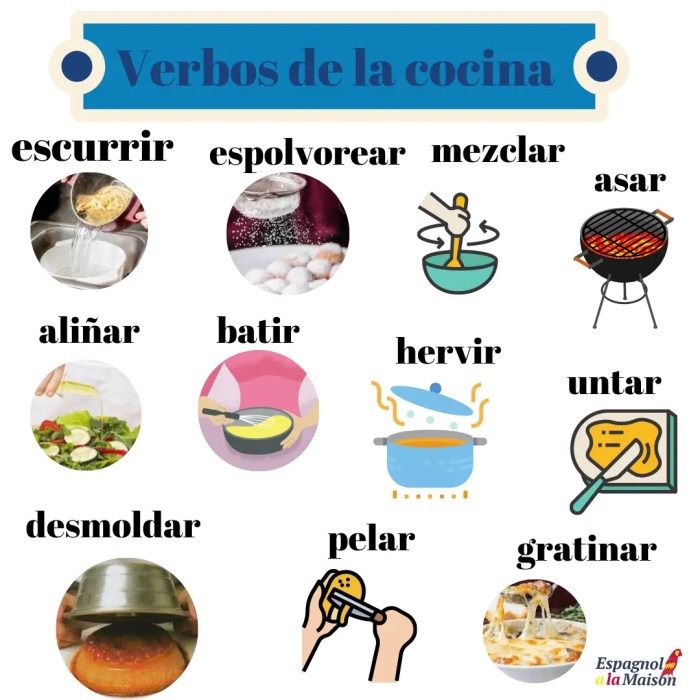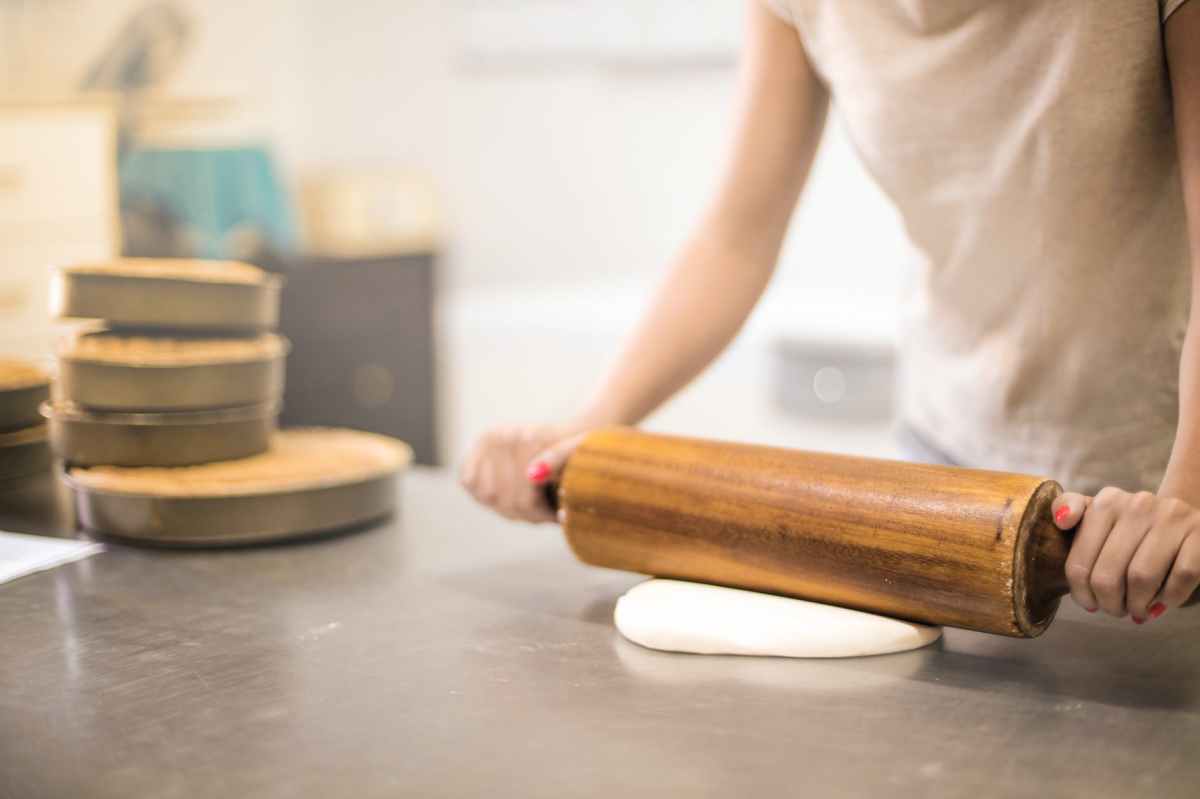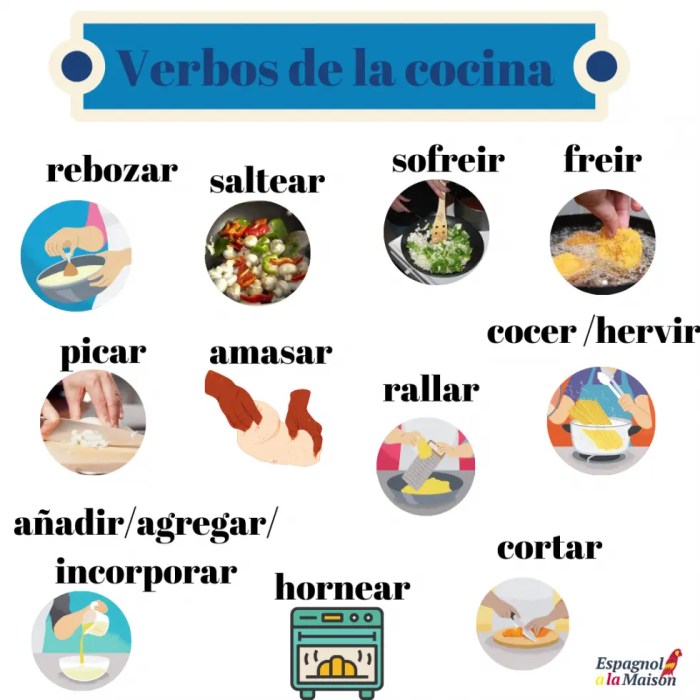Les verbes de la cuisine, the verbs of cooking, are the essential building blocks of culinary language, guiding us through the intricate world of flavors and techniques. From the sizzle of a sauté to the gentle simmer of a stew, verbs capture the essence of every culinary creation.
In this exploration of les verbes de la cuisine, we will delve into their significance, unravel their role in cooking, and uncover their nuances across diverse cuisines. Let us embark on a journey where verbs ignite our culinary passion and enhance our understanding of the art of cooking.
Verbs of Cooking
Verbs of cooking are the verbs used to describe the actions that are carried out in the kitchen. They are an essential part of culinary language, as they allow us to communicate how food is prepared.
There are many different verbs of cooking, each with its own specific meaning. Some of the most common verbs of cooking include:
- Sauté: to cook food in a pan with a small amount of fat over medium heat, stirring or tossing the food frequently.
- Grill: to cook food over an open flame or on a grill pan.
- Bake: to cook food in an oven.
- Roast: to cook food in an oven, typically at a high temperature.
- Fry: to cook food in hot oil.
- Boil: to cook food in boiling water.
- Simmer: to cook food in a liquid that is just below boiling point.
- Poach: to cook food in a liquid that is just below boiling point, but not boiling.
- Steam: to cook food by exposing it to steam.
- Microwave: to cook food in a microwave oven.
Verbs of cooking can be classified in a number of different ways. One common way is to classify them by cooking method. For example, sautéing, grilling, baking, roasting, and frying are all methods of cooking that use heat. Boiling, simmering, poaching, and steaming are all methods of cooking that use liquid.
Microwaving is a method of cooking that uses electromagnetic radiation.
Another way to classify verbs of cooking is by ingredient. For example, verbs such as sauté, grill, and bake can be used to cook a variety of different ingredients, including meat, poultry, fish, vegetables, and fruits. Verbs such as boil, simmer, and poach are typically used to cook liquids, such as soups, sauces, and stews.
Verbs of cooking are an essential part of culinary language. They allow us to communicate how food is prepared and to create a wide variety of dishes.
The Role of Verbs in Cooking
Verbs play a crucial role in cooking, guiding the process and ensuring successful results. They provide specific instructions on how to manipulate ingredients, control temperature, and achieve desired textures and flavors.
Les verbes de la cuisine sont essentiels pour décrire les actions de préparation des aliments. Si vous souhaitez approfondir vos connaissances en la matière, vous pouvez consulter les ressources disponibles en ligne, comme le nurs 110 final exam wcu . Ce site Web propose un examen final complet qui vous aidera à maîtriser les verbes de la cuisine et d’autres concepts liés à la préparation des aliments.
Choice of Verbs and Dish Outcome
The choice of verbs can significantly impact the outcome of a dish. For example, “simmer” and “boil” are both cooking methods involving heat and liquid, but they differ in temperature and intensity. Simmering involves gently heating a liquid just below boiling point, while boiling involves rapidly heating a liquid to its boiling point.
This difference in temperature affects the cooking time and the texture of the food.
Verbs Conveying Specific Techniques
Verbs can also convey specific cooking techniques. For example, “fold” refers to a gentle mixing technique used to incorporate ingredients without deflating them, while “whip” describes a rapid beating motion that incorporates air into ingredients, creating a light and fluffy texture.
Verbs of Cooking in Different Cuisines: Les Verbes De La Cuisine

Verbs of cooking play a crucial role in describing the culinary techniques and styles that vary across different cuisines. These verbs not only convey the actions performed on ingredients but also reflect the distinct cultural influences and culinary traditions of each region.
Unique or specialized verbs are often used in specific cuisines to describe specific cooking methods or techniques. For instance, in Chinese cooking, the verb “wok” refers to the technique of stir-frying ingredients in a large, round-bottomed pan. Similarly, in French cuisine, the verb “confit” refers to the process of preserving meat or poultry by curing it in salt and then slowly cooking it in its own fat.
Verbs in Chinese Cuisine
Chinese cuisine is known for its diverse cooking techniques, and its verbs of cooking reflect this variety. Besides “wok”, other common verbs include:
- Stir-fry:Cooking ingredients in a hot pan with constant stirring.
- Steam:Cooking ingredients over boiling water without direct contact.
- Braising:Browning ingredients in a pan and then simmering them in a flavorful liquid.
- Deep-fry:Submerging ingredients in hot oil until golden brown.
Verbs in French Cuisine, Les verbes de la cuisine
French cuisine is renowned for its precision and elegance, and its verbs of cooking reflect this. In addition to “confit”, other important verbs include:
- Sauté:Cooking ingredients in a pan with a small amount of fat.
- Roast:Cooking ingredients in an oven with dry heat.
- Blanch:Briefly boiling ingredients to remove impurities or enhance color.
- Poach:Cooking ingredients in a simmering liquid.
Verbs in Indian Cuisine
Indian cuisine is known for its complex spice blends and aromatic dishes, and its verbs of cooking reflect this richness. Some common verbs include:
- Tadka:Tempering spices in hot oil or ghee to release their flavor.
- Bhunna:Sautéing ingredients until they are browned and caramelized.
- Dhum:Smoking ingredients over hot coals to infuse them with a smoky flavor.
- Dum:Slow-cooking ingredients in a sealed pot to tenderize them.
The Importance of Verb Accuracy in Cooking
Accuracy in verb usage is crucial in cooking, as it ensures clear communication and precise execution of recipes. Imprecise or incorrect verbs can lead to confusion and errors, potentially compromising the final outcome of the dish.
For instance, consider the verb “fry.” This verb specifically refers to cooking food in hot oil or fat, creating a crispy exterior. Using the verb “cook” instead, which has a broader meaning, could lead to confusion about the intended cooking method.
Common Mistakes in Verb Usage
- Using “mix” instead of “stir”:Mixing involves combining ingredients without necessarily creating a smooth or uniform mixture, while stirring implies constant agitation to achieve a smooth consistency.
- Using “chop” instead of “dice”:Chopping involves cutting food into irregular pieces, while dicing specifically refers to cutting food into small, uniform cubes.
- Using “simmer” instead of “boil”:Simmering involves cooking food in liquid just below the boiling point, while boiling refers to cooking food in liquid that is actively bubbling.
Tips for Using Verbs of Cooking Effectively
Effectively using verbs of cooking is crucial for conveying clear and precise culinary instructions. By adhering to certain best practices, you can enhance the clarity and accuracy of your cooking communication.
Use Active Voice and Specific Verbs
Employ active voice to emphasize the subject performing the action. Specific verbs convey precise actions, eliminating ambiguity. For instance, instead of “The meat was cooked,” write “The chef seared the meat.”
Avoid Ambiguity and Vagueness
Avoid using vague verbs like “make” or “do.” Instead, opt for more specific verbs that accurately describe the cooking process. For example, instead of “Make the sauce,” specify “Whisk the sauce” or “Simmer the sauce.”
Use Consistent Verb Tense
Maintain consistency in verb tense throughout your recipe or culinary description. For instructions, present verbs in the imperative or present tense. For past actions or completed dishes, use the past tense.
Proofread for Accuracy
Thoroughly proofread your writing to ensure the accuracy of verb usage. Check for any inconsistencies or ambiguous language that could lead to confusion or misunderstandings.
Examples of Verb Tables in Cooking

Verbs play a pivotal role in cooking, conveying the actions and processes involved in creating culinary masterpieces. To illustrate the diverse range of verbs used in cooking, we present a comprehensive table with four responsive columns:
Types of Cooking Verbs
The table categorizes verbs based on their cooking methods and provides examples to showcase their specificity:
| Verb | Cooking Method | Example | Image |
|---|---|---|---|
| Sauté | Pan-frying with a small amount of fat | Sautéing onions for a flavorful base | [Image: Sautéing onions in a skillet] |
| Roast | Cooking in an oven with dry heat | Roasting a chicken for a crispy exterior and tender interior | [Image: A roasted chicken on a baking sheet] |
| Grill | Cooking over direct heat on a grate | Grilling steaks for a smoky, charred flavor | [Image: Grilling steaks on a barbecue] |
| Bake | Cooking in an oven with indirect heat | Baking a cake for a fluffy and moist texture | [Image: A baked cake on a cooling rack] |
| Simmer | Cooking in a liquid just below boiling point | Simmering a soup for a rich and flavorful broth | [Image: A simmering pot of soup] |
| Fry | Cooking in hot oil or fat | Frying potatoes for crispy and golden-brown results | [Image: Frying potatoes in a deep fryer] |
Conclusion

In conclusion, verbs play a pivotal role in cooking, enabling precise communication and successful execution of culinary creations. Understanding and utilizing verbs of cooking effectively enhances culinary skills, allowing individuals to convey their intentions accurately and achieve desired outcomes in the kitchen.
Exploring the world of verbs of cooking further empowers individuals to delve deeper into the intricacies of culinary arts, unlocking a wealth of knowledge and techniques. By mastering these verbs, cooks can elevate their culinary prowess and create dishes that are both delicious and visually appealing.
FAQ Guide
What is the importance of using accurate verbs in cooking?
Accurate verbs ensure clear and precise communication in recipes, preventing confusion and potential errors.
How do verbs convey specific cooking techniques?
Verbs like “fold” and “whip” describe specific hand movements and techniques used in cooking.
How do cooking verbs vary across different cuisines?
Different cuisines have unique verbs that reflect their distinct cooking styles and ingredients, such as “wok” in Chinese cooking and “confit” in French cuisine.